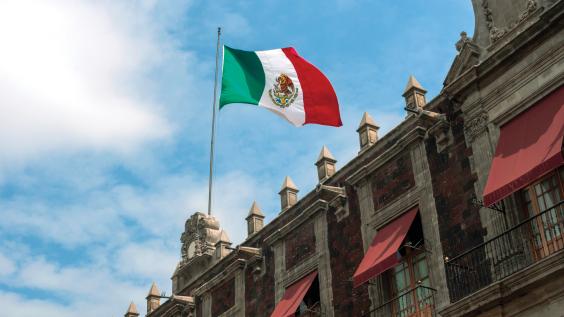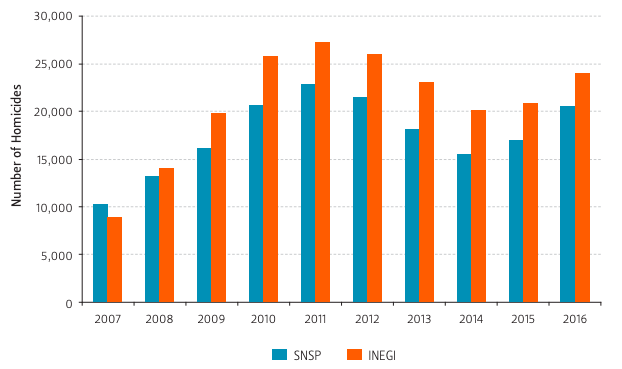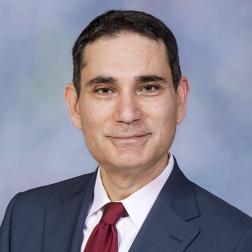Mexico’s Security Challenges Are Jeopardizing Its Future

Table of Contents
Author(s)
Share this Publication
- Download PDF
- Print This Publication
- Cite This Publication Copy Citation
Payan, Tony. 2017. Mexico’s Security Challenges are Jeopardizing Its Future. Issue brief no. 12.18.17. Rice University’s Baker Institute for Public Policy, Houston, Texas.
Introduction
Mexico’s public safety and security were severely challenged between 2007 and 2012, a period marked by a dramatic rise in the number of homicides and other violent crimes (Figure 1). The situation was widely considered to be the result of President Felipe Calderón Hinojosa’s frontal assault on organized crime, which included the deployment of federal police and the military throughout the country. The administration argued that its crackdown paradoxically resulted in greater violence in the short-term because criminals responded by lashing out against the government, tightening their grip on society by expanding the scope of their criminal activities, and—eventually—fighting each other for control of their illegal but highly profitable enterprises.
Figure 1 — Homicides in Mexico, 2007–2016

Note The preliminary 2017 homicide rate is not included in Table 1, but is on track to exceed that of 2011. As of August 31, 2017, the estimated number of homicides was 16,318.
The logic behind the strategy, as outlined by Joaquín Villalobos in De los Zetas al cártel de la Habana,1 was to target cartel leaders through military force, which destabilized the organizations, causing them to fragment into smaller groups. The approach came as the powerful cartels challenged the viability of the Mexican state and ultimately controlled the country’s criminal activity. The second part of the plan was to strengthen law enforcement and the judicial system, which could in time successfully arrest and prosecute members of the smaller gangs. However, the result of the strategy— including the deaths of tens of thousands of people—horrified the public and eventually cost Calderón’s National Action Party (PAN) the presidency in 2012.
Enrique Peña Nieto of the Institutional Revolutionary Party (PRI) took office at the end of 2012 with two major goals in mind: 1) a reduction of overall violence, though not necessarily of crime in general, and 2) a singular focus on pushing through structural reforms, such as those affecting the energy industry, the administration of justice, and elections. To accomplish his first objective, he eliminated the Ministry for Public Safety—the agency behind Calderón’s strategy—and ended the government’s military campaign against organized crime.
Peña’s approach did reduce crime for a time, but the incidence of homicides and other crimes gradually crawled back up to record levels: Statistics suggest that 2017 may be the most violent year on record since the Mexican Revolution (c. 1910-1920), and that violent crime levels may exceed those of the Calderón administration.2
Today, the central question is whether, by letting up on the fight against organized crime, Peña is in a situation that jeopardizes the success of the structural reforms that are the legacy of his presidency.
The Post-Calderón Configuration of Organized Crime in Mexico
In at least one respect, Calderón’s crime strategy appeared to have had the intended results well into Peña’s administration (2012- 2018). Large organized crime organizations splintered into many smaller—albeit powerful—gangs that controlled criminal activity in smaller towns, medium-size cities, sections of larger cities, specific roads and highways, and some rural areas. In 2011, nearly 120 criminal groups operated in Mexico; they often consisted of a few dozen members carrying out criminal activities—including extortions, kidnappings, theft, and even murders—in confined territories.3 By 2017, such criminal groups numbered almost 220 throughout the country.4 At the same time, new offenses were added to their long list of criminal activities—including fuel theft,5 train robberies,6 and illegal natural resource extraction.7
Thus, crime in Mexico during the post-Calderón era has had three major characteristics. First, large criminal cartels have fragmented into smaller groups. Second, the smaller groups control specific territories and corridors throughout the country. And third, their criminal activities have expanded and diversified.
The Missing Half Strategy
The Peña administration, however, never followed through on the second component of the Calderón strategy: it did not strengthen law enforcement efforts and the judicial system or develop a long-term national public safety and security strategy to confront the many smaller criminal groups. Instead, as previously noted, Peña pulled back from Calderón's strategy to focus on structural reforms.
Consequently, criminal groups multiplied further and consolidated their stranglehold on cities, towns, and transportation corridors; acquired weapons with higher firepower; monopolized criminal activity within their territories; enhanced their ability to intimidate the population; corrupted or intimidated more mayors and governors; and increased their violent activities. The situation now threatens to derail Peña administration reforms—in particular, the historic energy reforms that opened the sector to foreign investment. In multiple conversations with the chief security officers (CSOs) of energy corporations, it is clear that the personal security of their staff and safeguarding their equipment from organized crime are key components of their business model when setting up operations in Mexico. One CSO stated that the company is likely to cease operations in the state of Tamaulipas because of threats from criminal groups.8
Obstacles to Progress in Public Safety and Security
Several factors suggest that it may be too late for Peña to substantively change Mexico’s criminal landscape before the election of a new president in July 2018. First, he still appears unwilling to confront organized crime head-on—and in any case, he does not possess the institutional capacity to do so, as the federal police has been weakened, the military is reluctant to intervene without clear rules of engagement, and there does not seem to be a clear strategy or serious coordination with governors and large city mayors to combat the cartels. In addition, accusations of corruption that he and his cabinet have faced have deprived him of the moral high ground when it comes to crime.
Second, because he chose to spend most of his political capital on consolidating his administration’s signature policy—structural reforms—he neglected to ensure that the judicial reforms of 2008 were fully implemented. Thus, he lacks the judicial capacity to prosecute criminals in any meaningful way.
Third, President Trump’s words and actions have distracted the Peña administration, which has turned its attention to managing Mexico’s relationship with the United States, particularly in light of NAFTA renegotiations. The turbulence that Trump’s position toward Mexico has created is an unresolved issue to date and one that will likely take the next year—until the end of Peña’s term—to resolve. Combined with the effort that will be devoted to the upcoming election, which his party (the PRI) is determined to win, there is little time left to substantively address the issue of Mexico’s public safety and security.
Fourth, the Mexican public has affirmed its desire for a plural government in every partial election (2015, 2016, and 2017) since Peña took office as president. Today, no one party controls all three branches of the federal government or all state and local governments. The fragmentation of government along party lines has weakened the ability of various government entities to work together against crime. It has also made mayors and governors more vulnerable to corruption and intimidation—and therefore more willing to accommodate criminal gangs to avoid further violence. In addition, it appears that the need to provide for the public’s safety and security by aggressively confronting organized crime has been trumped by the Peña administration’s desire to lower the incidence of violence in the run-up to the 2018 general election—an election that will fill over 3,000 positions, including the presidency and both houses of Mexico’s congress.9 Confronting organized crime can only increase violence-in the short-term at least-and the political cost to Peña’s party. Faced with this dilemma, the Peña administration has chosen to let up on fighting criminal groups.
A solid, coherent strategy to fight crime will apparently have to wait the next administration. Even then it is not known if a new president will be willing to tackle Mexico’s security problem with a long-term strategy, although many of the current conditions will likely prevail well into the next sexenio.10
Possible Scenarios and the Upcoming Government Agenda
An examination of Mexico’s current organized crime landscape and the Peña administration’s actions—or lack thereof—gives rise to several crucial questions:
1. What is the most likely government approach to fighting organized crime during the next administration (2018–2024)?
While it may be difficult to visualize the most likely scenario for confronting organized crime in the coming years, some assumptions can be made that help answer this question. Political fragmentation is likely to continue without a truly national approach to organized crime. Mexicans are not likely to give any one political party full control of government, and multiparty governance will continue to hinder intergovernmental coordination against organized crime. In other words, the political and electoral calculations of elected officials—rather than a well-crafted, longterm public policy approach largely fueled by the public’s desire for governmental checks and balances—will heavily influence the government’s response to organized crime. Another assumption is related to the elimination of the Ministry for Public Safety. This has weakened the central response to crime. The ministry cannot be reconstructed overnight, so most governors and mayors cannot rely on a federal agency to help them respond effectively to organized crime. Thus, Mexico will likely continue to muddle through its public safety and security problems, with no long-term strategy, for at least another year and quite possibly longer.
2. Will criminal activity jeopardize the implementation of structural reforms, especially in the energy sector?
Public safety and security understandably concern foreign energy companies investing in Mexico; kidnapping, extortion, theft, and recurrent taps into pipelines are real and growing problems. As previously mentioned, some have already said that they are rethinking their investments in light of Mexico’s poor record of public safety and security. Criminal activity against their in-country assets and personnel is growing. Their business models must now include additional resources for managing their safety, as the government is unable to provide it.11 Clearly, the success of energy and other reforms is threatened by organized crime and the government’s inability and unwillingness to deal with the problem.
3. Will Mexico’s criminals reconfigure their organizations again as they rediscover the advantages of forming alliances, consolidating operations, and controlling larger territories for maximum profit?
In the current political environment, criminal gangs could reconsolidate to combine their power and reach. There are early signs that some groups—including the Cartel Jalisco Nueva Generación (CJNG), the Gulf Cartel, and even Los Zetas—are finding ways to coopt smaller criminal cells (which are often referred to as “orphans” because they operate independently, outside a cartel structure). This is currently more theory than fact, but evidence will surely accumulate over the next two years.
Should a reconsolidation occur across the board, the result will be rising violence as the groups fight each other for supremacy within the larger organization and expand their criminal operations to extract greater resources from local populations in their territories. Some experts argue that the consolidation of organized crime groups requires a strong central government that views the mergers of organized criminal groups as advantageous. The government’s purported reasoning: both sides can more easily negotiate a mutual accommodation if only a few parties are on the wrong side of the law. The same experts argue that as long as the government remains politically divided and weak, there will be no incentive for criminals to accommodate the social order imperatives of the government, and criminal activities will continue to flourish under the current circumstances: many groups, territorial fragmentation, and criminal diversification.
Thus, as Mexico approaches a general election in mid-2018, a major issue is whether the precipitous rise in the country’s violent crime will jeopardize the success of the structural reforms of the Peña administration by deterring foreign investment and providing legitimacy to political alternatives unfavorable to the reforms, such a populist left that seeks to reverse them. The answer will come in July 2018 when Mexican citizens—who are increasingly demanding that the government reduce crime and violence—let their voices be heard at the polls.
Conclusion
The criminal landscape in Mexico is complex, but the Calderón administration’s strategy to combat it has not been pursued for the last five years. The consequence is that Mexico’s violence and crime has increased to record levels and citizens are increasingly demanding radical change. In addition to the growing hesitation of energy companies to invest in Mexico—although they still consider it a lucrative market—crime and violence are causing citizens to turn to populist alternatives that may reverse newly implemented structural reforms. Although it is difficult to predict what will happen, as there is no political clarity in Mexico, the country is at a crossroads and implementing existing laws against organized crime is likely to be the greatest challenge of the next administration.
Endnotes
1. Joaquín Villalobos, “De los Zetas al cártel de la Habana,” Foreign Affairs Latinoamérica 11, no. 2 (April-June 2011): 9-21.
2. “Crimen en México: Reporte Mensual Sobre la Delincuencia en México,” https://elcri.men/, accessed November 5, 2017.
3. Eduardo Guerrero Gutiérrez, “La raíz de la violencia,” Revista Nexos, June 1, 2011, https://www.nexos.com.mx/?p=14318.
4. This number was obtained by the author during a November 2017 conversation with a public safety and security expert at a security-related meeting in Ciudad Victoria, Tamaulipas.
5. Situación actual y perspectivas sobre el robo de hidrocarburos en México 2016, Reporte Sectorial 2016.
6. Imagen Noticias, “Así es como los delincuentes roban trenes en México,” September 15, 2017, https://www.youtube.com/watch?v=GyXtdWU8bv8.
7. The Global Initiative against Transnational Organized Crime, Organized Crime and Ilegally Mined Gold in Latin America, April 2016, http://globalinitiative.net/wp-content/uploads/2016/03/TGIATOC-OC-and-Illegally-Mined-Gold-inLatin-America-Report-1718-digital.pdf.
8. Over the last three years, the Mexico Center has maintained a close dialogue with many CSOs; all we have spoken to have had to deal with organized crime activities, from the kidnapping of their staff to theft.
9. Baker Institute Mexico Center, Mexico Election Resource Center, 2017, https://www.bakerinstitute.org/mexico-2018-election-resource-center/.
10. A sexenio refers to the federal administration’s term in office—six years.
11. This conclusion was drawn from conversations with CSO officers of large and medium-size energy companies and during working groups on energy and security, including those of the Overseas Advisory Council.
This material may be quoted or reproduced without prior permission, provided appropriate credit is given to the author and Rice University’s Baker Institute for Public Policy. The views expressed herein are those of the individual author(s), and do not necessarily represent the views of Rice University’s Baker Institute for Public Policy.



